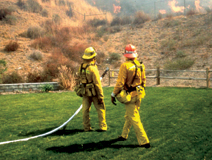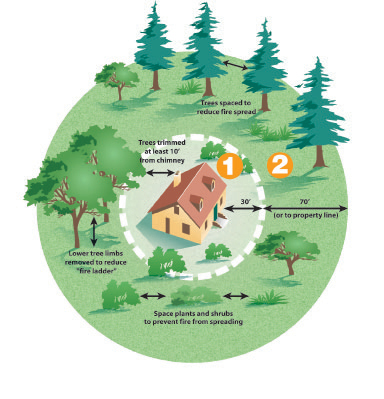Defensible Space
Providing a “defensible space” can reduce the risk of structural damage caused by fire. This space, at least 100 feet wide in California, is the area surrounding a structure where plants are maintained to decrease the fire hazard and provide an opportunity for firefighters to safely defend your home. Vegetation that does not ignite easily should be planted in the defensible space. Landscape plants protect soils from erosion and provide aesthetic and ecological benefits. Trees and shrubs are acceptable as long as they are widely spaced and do not provide a continuous path of fuel for a fire to climb from the ground to a tree crown or roof (a fuel ladder). Proper landscape maintenance can dramatically improve the fire safety of a yard.
Photo courtesy of Los Angeles County Fire Department, Forestry Division
DEFENSIBLE SPACE GUIDELINES Below are general guidelines adapted from CAL FIRE:
1. Create and maintain a defensible space of at least 100 feet or greater from each building or structure. In Zone , from the home to a distance of 30 feet, keep plants low, and make sure to have irrigation available when needed. Check with your local fire department about the exact distances required in your area.
2. Preserve single specimens or groupings of well-spaced and well-pruned trees or other vegetation.
3. Eliminate ladder fuels within the defensible space zone by disrupting the vertical and/or horizontal continuity of plants.
Figure courtesy of CALFIRE
FIRE-SAFE LANDSCAPING
You can improve the fire safety of your property by properly designing and maintaining your landscape. Make sure there is horizontal and vertical separation between plants. If a fire occurs, this will minimize the spread of fire between your plants, and from your plants to your home. Choose fire resistant plants. It is important to understand, though, that all plants will burn given the right conditions. Ensure plants are properly irrigated. Dead leaves, branches and other flammable debris should be regularly removed. Fire-safe landscapes should also include hardscape materials, like granite paths of stone walls These can act as a fuel break and help to slow down or change the path of an approaching fire. Make sure to keep flammable things like firewood piles and propane tanks away from your home, and remember that the house itself can be made more fire resistant. Finally, in all cases, maintain your plants and property throughout the year to reduce the amount of fuel near your home.
Brush, Fuel and Vegetation — Clearance, Maintenance, Management, Mitigation, Modification, Thinning, Reduction, and Treatment
These terms are typically used interchangeably to mean the maintenance of vegetation (trees, shrubs, grasses, groundcovers, and vines) in a way that minimizes the transmission of fire from one plant to another, and ultimately, to your house. Proper maintenance for fire safety does not mean eradication of all plants, but rather the selective removal of highly flammable vegetation. The goal of brush clearance is not to remove all vegetation, but to specifically remove fuels that create a fire hazard. When done well, “cleared” areas should still include enough well-spaced and judiciously pruned plants to protect against excessive erosion and provide wildlife habitat.




